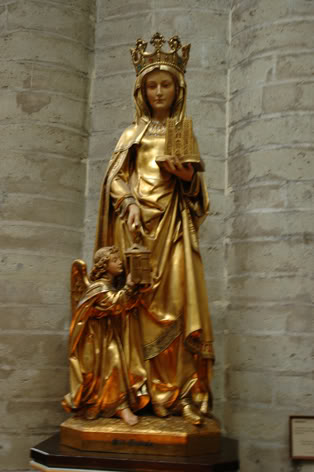 Born in 410 in North Africa, Severinus was a monk, hermit, and founder. He laboured to evangelise the region of Noricum (part of modem Austria), establishing a number of monasteries along the Danube River near modern Vienna. In his last years, he gave aid and comfort to the many refugees and victims of the invasion of the region by Attila and the Huns. He was known for his preaching and prophecies, Severinus died on 5 January 482. His relics were later carried to Naples. Italy, and enshrined in the Benedictine monastery of San Severino.
Born in 410 in North Africa, Severinus was a monk, hermit, and founder. He laboured to evangelise the region of Noricum (part of modem Austria), establishing a number of monasteries along the Danube River near modern Vienna. In his last years, he gave aid and comfort to the many refugees and victims of the invasion of the region by Attila and the Huns. He was known for his preaching and prophecies, Severinus died on 5 January 482. His relics were later carried to Naples. Italy, and enshrined in the Benedictine monastery of San Severino.
 Gudula was born in Brabant, Belgium, of Witger and Amalberga, in the seventh century. she died at the beginning of the eighth century. After the birth of Gudula her mother Amalberga, who is herself venerated as a saint, embraced the religious life, and according to tradition received the veil at the hands of St Aubert, Bishop of Cambrai (d. about 668). Gudula’s sister was St Reinelda, and her brother, St Emebertus, who succeeded St Vindician as Bishop of Cambrai about 695. From an early age Gudula proved herself a worthy child of her mother, and with Reinelda and Emebertus lived in an atmosphere of piety and good works. She frequently visited the church of Moorzeele, situated at a distance of two miles from her parents’ house. She was buried at Ham (Eastern Flanders). About a century after her death, her relics were removed from Ham to the church of Saint-Sauveur at Moorzeele, where the body was interred behind the altar. Under Duke Charles of Lorraine (977-992), or more exactly, between 977 and 988, the body of the saint was taken from the church of Moorzeele and transferred to the chapel of Saint Géry at Brussels. Count Balderic of Louvain caused another translation to be made in 1047, when the relics of the saint were placed in the church of Saint-Michel. Great indulgences were granted on the feast of the saint in 1330, to all who assisted in the decoration and completion of the church of St. Gudula at Brussels. On 6 June1579, the collegiate church was pillaged and wrecked by the Gueux and heretics, and the relics of the saint disinterred and scattered. The feast of the saint is celebrated at Brussels on 8 January, and at Ghent — in which diocese Ham and Moorzeele are located—on 19 January.
Gudula was born in Brabant, Belgium, of Witger and Amalberga, in the seventh century. she died at the beginning of the eighth century. After the birth of Gudula her mother Amalberga, who is herself venerated as a saint, embraced the religious life, and according to tradition received the veil at the hands of St Aubert, Bishop of Cambrai (d. about 668). Gudula’s sister was St Reinelda, and her brother, St Emebertus, who succeeded St Vindician as Bishop of Cambrai about 695. From an early age Gudula proved herself a worthy child of her mother, and with Reinelda and Emebertus lived in an atmosphere of piety and good works. She frequently visited the church of Moorzeele, situated at a distance of two miles from her parents’ house. She was buried at Ham (Eastern Flanders). About a century after her death, her relics were removed from Ham to the church of Saint-Sauveur at Moorzeele, where the body was interred behind the altar. Under Duke Charles of Lorraine (977-992), or more exactly, between 977 and 988, the body of the saint was taken from the church of Moorzeele and transferred to the chapel of Saint Géry at Brussels. Count Balderic of Louvain caused another translation to be made in 1047, when the relics of the saint were placed in the church of Saint-Michel. Great indulgences were granted on the feast of the saint in 1330, to all who assisted in the decoration and completion of the church of St. Gudula at Brussels. On 6 June1579, the collegiate church was pillaged and wrecked by the Gueux and heretics, and the relics of the saint disinterred and scattered. The feast of the saint is celebrated at Brussels on 8 January, and at Ghent — in which diocese Ham and Moorzeele are located—on 19 January.
If St. Michael is the patron of Brussels, St. Gudula is its most venerated patroness. In iconography, St Gudula is represented on a seal of the Church of St Gudula of 1446 reproduced by Père Ch. Cahier (Caracteristiques des saints, I, 198) holding in her right hand a candle, and in her left a lamp, which a demon endeavours to extinguish. This representation is doubtless in accord with the legend which relates that the saint frequently repaired to the church before cock-crow. The demon wishing to interrupt this pious exercise, extinguished the light which she carried, but the saint obtained from God that her lantern should be rekindled. The flower called “tremella deliquescens”, which bears fruit in the beginning of January, is known as “Sinte Goulds lampken” (St Gudula’s lantern). The old woodcarvers depict St Gudula with a taper in her hand.
